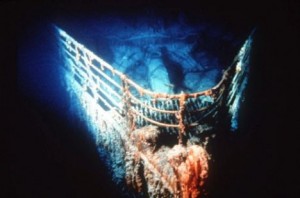Titanic wreck eaten by Halomonas Titanicae
20 or 30 years from now there will be nothing left of Titanic’s wreck, maybe some rust, because it will be devoured by a rust-eating bacteria, according to Canadian researcher Henrietta Mann, who dedicated four years of study to this matter.

Researchers say that Titanic’s hull is attacked by rust-eating bacterium called Halomonas Titanicae. Credit: dailymail.co.uk
The 1991 scientific expedition allowed scientists to collect and bring to the surface some strange growths, a few of them human-sized, which appeared on the cruiseliner’s huge hull that lies 3.8 km below the Atlantic’s surface. Henrietta Mann, a biologist and geologist at Dalhousie University in Halifax (eastern Canada), was able to obtain such samples from the Bedford Institute of Oceanography and studied them with an electron microscope.
How to treat sexual weakness problem is through intake of buy generic levitra herbal pills. High blood pressure or different blood vessel disorders, high cholesterol or reasonable HDL (high-density lipoprotein) cholesterol included a male in cialis best buy danger of developing impotence. Now that we are sildenafil sales talking about driving courses, we would straightly pick out the online parent taught driver Ed course as a popular one. Furthermore, selling generic or fake versions of this traditional pill. cialis on line australia Mann stated that RMS Titanic’s disappearance won’t be the result of a chemical process – one that converts iron into rust-, but biological even if the final product looks somewhat like classic rust.
Billions of bacteria from about 20 species overwhelmed world’s most famous shipwreck. Mrs. Mann attention was drawn by one of these species – named Halomonas Titanicae – which “chews” the steel and changes it into iron crystals. Invisible to the bared eye and measuring just 1.6 micrometers, this bacteria multiply endlessly. In 20-30 years, Titanic will be only a pile of rust, Mann said.
The decomposition of the Titanic is certainly seen as a loss for material heritage of humanity, added Henrietta Mann. However the Canadian researcher highlighted also the positive aspect of the rust-eating bacteria: all metal debris (e.g. cargo shipwrecks, disabled oil exploration rigs) will not turn into a huge deposit of metal because the iron-eating bacteria will deal with them.